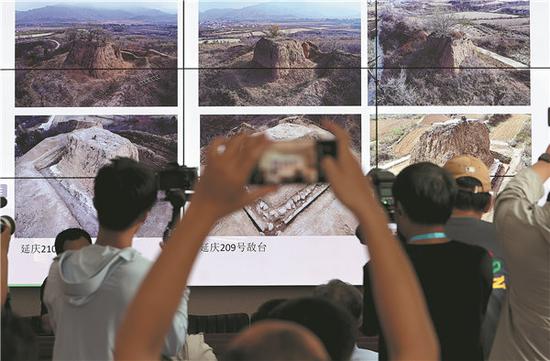Great Wall restoration teams uncover trove of secrets

Clouds seem to run like a river beneath the Jiankou Great Wall in Beijing's Huairou district. (Photo by Sun Yonggong/For China Daily)
Latest technology identifies construction techniques to better protect iconic structure.
Archaeology has played an increasingly important role in understanding the Great Wall that stretches across the rugged landscapes of northern China, experts agreed at a recent seminar, which is a reflection of the country's increasing focus on the Great Wall protection.
In May, President Xi Jinping called for continued efforts to protect the Great Wall, promote its culture and pass on the precious heritage to future generations.
Xi made the remarks in his reply to a letter from residents in Shixia village at the foot of the Badaling Great Wall. The letter recounted their work in protecting the Great Wall and changes taking place in the village.
Xi noted that the Great Wall is a representative symbol of the Chinese nation and an important symbol of Chinese civilization. Since the 18th CPC National Congress in 2012, Xi has attached great importance to tapping into the cultural value of the Great Wall and the conservation of its cultural relics, and has given multiple important instructions on advancing the construction of the Great Wall National Cultural Park.
A dozen projects have been conducted on the sections of the Great Wall in Beijing, with most of them in Huairou district in the northeast of the capital city and Yanqing district in the northwest, says Shang Heng, associate research fellow at the Beijing Institute of Archaeology at the seminar in Beijing's Huairou district on Friday.
Related studies have shed light on the Great Wall's architectural form and construction techniques.
"For example, although certain sections of the Great Wall are not very long, they employ a variety of construction methods," Shang says.
"In steep mountainous areas, the technique involved chiseling the mountain into a staircase shape. In gentler areas, foundation trenches were dug. In some places, soil was used to create a base," he adds.
The Beijing sections of the Great Wall are one of the most well-preserved and complex among those meandering through more than 10 provinces, autonomous regions and municipalities. They run more than 520 kilometers across six districts in the city.
In 2021, Beijing shifted its focus from general protection of the Great Wall to research-based restoration, selecting the Dazhuangke section in Yanqing and the Jiankou section in Huairou as pilot sites for research-based restoration.
"Previously, we only observed the Great Wall from the surface and didn't understand the buried parts, making it difficult to create comprehensive and scientific protection plans. By using archaeological methods to observe, diagnose and treat, we can identify the root cause of the Great Wall's issues and provide targeted treatments," Shang explains.
In recent years, artifacts unearthed from the Great Wall in Beijing can be categorized into three major types: architectural components of the wall, weapons and daily utensils, Shang says.
In 2022, researchers discovered charred grains from the Ming Dynasty (1368-1644) on the Dazhuangke section of the Great Wall, including millet and Chinese prickly ash.
Although these grains were charred, they have provided an authentic representation of the daily diet of the Great Wall garrison soldiers, Shang says. He notes that a pile of more than 50 stone grenades found on the Badaling Great Wall last year was a major discovery.
"This updates our previous understanding of the weapons used by the Great Wall garrisons. We used to think that they mostly used long-range weapons and that there weren't many close-combat weapons," Shang says.
However, the stone grenades being stashed away in several watchtowers within a short section of the Badaling Great Wall suggests that they were likely commonly equipped along the entire length of the Great Wall, he adds.
Shang is among several archaeologists and cultural heritage preservationists from across the country, including Hebei province, the Inner Mongolia and Xinjiang Uygur autonomous regions and Shaanxi province, who engaged in discussions and exchanges about their distinct archaeological experiences at the seminar that was hosted by the Huairou district government and the Beijing University of Civil Engineering and Architecture.
They concur that archaeology plays an important role in addressing the chronological classification of the Great Wall, deepening the overall understanding of the Great Wall's defense system, interpreting the techniques of its defensive structures, identifying the causes of deterioration of the wall, and enriching its knowledge.
Han Jinqiu, a senior researcher from the Hebei Provincial Institute of Cultural Relics and Archaeology, says that the recent years of work on the Great Wall in the province has been about filling in gaps in the chronology of the Great Wall, studying sections that have been recently uncovered and addressing certain previous misunderstandings.


